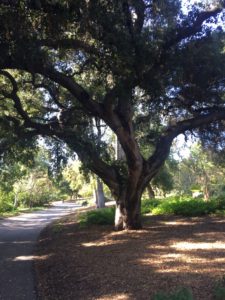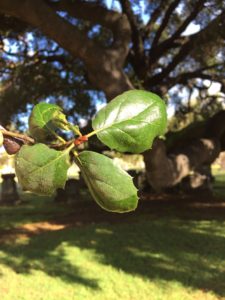Quercus agrifolia, the coast live oak, is one of the most majestic trees in Southern California. These native beauties dot our hillsides and create shade and wonder in our landscapes.
Because these trees evolved in our region, they are an excellent choice for the water wise garden. Beauty and sustainability is our mission here at Creative Concepts Landscape.
Quercus agrifolia (coast live oak) basics:
- Common names: California oak, live oak
- Large trees; 25 – 85 feet tall, 15 – 25 feet wide
- Growth habit (plant form): Rounded, spreading
- Slow to moderate growth rate
- Evergreen
- No noticeable fragrance
- Flowers: The flowers are fairly inconspicuous (not very noticeable) on female specimens, but larger and pendulous on male specimens –both are small with a green/cream/white color
- Blooming season: Winter and spring
- Fruit: acorns which attract a variety of wildlife, including birds

Young acorns of the coast live oak
Native Range
Coast live oaks mostly grow in their native range west of the California Central Valley, from Baja Mexico to Mendocino County in the northern part of the state.
Coast live oak thrives in our coastal environment (hence the name), however they are rare on at the immediate shore. These trees benefit from the mild winter and summer climate created by the close proximity to the ocean, and the marine layer supplies water even during drought periods.
Coast live oaks are the dominant overstory (trees with high canopies) of California oak woodlands.

Quercus agrifolia‘s native range
Tree & Leaf Structure
Coast live oaks can have a wide variety of forms, however they tend settle on a large, rounded habit. Typically, they have many thick branches spreading both horizontally and vertically in contorted forms. Exquisite.

The large, sprawling habit of a mature coast live oak
Younger specimens tend to be shrubby, but as they age the trunk and branches become well defined with a lower leaf density. Some specimens will live longer than 250 years. These heritage oaks can be found throughout the Crescenta Valley.
Coast live oak leaves are dark green, oval, with a convex shape. The leaf margins (the edges) are spiny-toothed. These leaves have evolved for maximum solar absorption with their shape and multiple layers (2 to 3) of photosynthetic cells.

The convex shape and spiny margins of the coast live oak leaf
The overall rounded shape of these trees, generally, when left to grow into their natural form, swoop down towards the ground in a semi-circle. This form, along with the shape of the leaves, helps to form a wind break around the tree, providing protection from powerful gusts.
Coast Live Oaks in the Landscape
Creative Concepts Landscape promotes the right tree for the right location. Every landscape is different, so considerations must always be made. Coast live oaks are beautiful, water wise native trees that can potentially be a wonderful addition to your landscape, however they are large trees, both in height and width. They need room to expand. Planting a coast live oak, however small one might be in youth, in a tight location will cause issues later in life. These trees, generally, do not respond well to severe pruning, so trying to force them into a tight fit will often end in heartbreak.

A mature specimen providing ample shade and beauty in the landscape
However, if you have the available space, these trees are an excellent choice.
Coast live oaks are fairly easy to grow. They need supplemental irrigation about once a week for the first year after planting. After the first year, the tree will begin to become established and the supplemental watering can be reduced to around one time per month. Once the tree is around 10 feet tall, and in healthy condition, they might not need any supplemental irrigation at all.
In areas with very little rainfall, it is best to plant the tree near, but not directly next to, an irrigated area. They will get their water by growing their roots out. Having irrigation directly next to the trunk of the tree will potentially harm it.
Coast live oaks prefer to have their roots shaded, so surrounding young trees with mulch (but not directly against the trunk) rocks, or symbiotic understory plants (such as toyon) that will not crowd out the tree, will help to provide that shade.
One of the best things you can do for an oak tree is allow its fallen leaves to stay, creating a mulch layer beneath the canopy. These leaves will amend the soil over time and create a highly beneficially fungal community in the soil (it will also help to reduce weed growth underneath the tree). Over time this will create an area of highly fertile soil that will improve the health of nearby plants.
Creative Concepts Landscape will create a plan and properly install coast live oaks for your landscape. Contact us today to learn more.
Summer Dormancy
Because coast live oaks evolved in our climate, they have become summer dormant (many trees go dormant in the winter). This helps the coast live oaks to reduce their water intake during the driest times of the year.
One might think that these trees would need extra water on those hot summer days, but the opposite is true for these oaks. Established trees should not be watered at all during the summer.
Because the trees reduce their water intake at this time, supplemental water will sit around the roots, creating potential damage. Lucky you, these trees are making it easier to reduce your water bill.
Quercus agrifolia (coast live oak) landscape basics:
- Full sun to part shade
- Once established, they tend to need little supplemental water – maximum one time per month once established
- They usually tolerate a variety of soil types, but prefer well draining loamy soil. This type of soil will be naturally created if you let the leaves form into a base mulch layer
- Excellent in the landscape for bank stabilization, specimen focal points, deer resistant, bird gardens, and butterfly gardens
- The flowers are inconspicuous, male flowers are pendulous
- Cold hardy to 15 degrees F
- Fertilizer is not necessary

The pendulous flowers of a male specimen
Maintenance
Coast live oaks are susceptible to several pests and diseases including Gold Spotted Oak Borer and Sudden Oak Death. Avoid importing firewood from areas outside of where it was grown. Firewood can carry pests within it.
Sterilize all pruning instruments before and after use when trimming these trees.

A multi-trunked coast live oak along a park pathway
It is best to prune coast live oaks in July or August, when the trees are in dormancy and not growing. Also, the dry weather is less likely to encourage pathogens that may attack the pruning wounds.
Always avoid pruning large limbs (unless there is an imminent safety risk with the tree). Removing large limbs creates large wounds which expose the tree to possible infection and will take many years to recover.
Avoid over-thinning interior branches or “lion tailing.”
Coast live oaks are one of our natural wonders in the Crescenta Valley. Creative Concepts Landscape will help to give your oaks a healthy start in life.
DO YOU have Quercus agrifolia, or any other locally common plant in your landscape? We want to see them! Please upload a picture of your beauty in the comments.

Mature coast live oaks will form massive trunks and limbs. This particularly grand tree is located in Mountain View Cemetery.
Do you have a landscape project in mind? Whether it’s planting oak trees, repairing irrigation, or any other landscape project, Creative Concepts Landscape will be happy to discuss possibilities with you. Take a look at our Yelp page and contact us today (818 248-7436), to see what we can do for your landscape.
By Daniel Williams
Client Liaison for Creative Concepts Landscape
Resources:
Hahamongna Native Plant Nursery – Take a hike around JPL and stop by this local nursery specializing in native plants – open to the public on the weekends
Theodore Payne Nursery – Specializing in local native plants for our region
Descanso Gardens – A local La Canada destination with beautiful coast live oak groves

